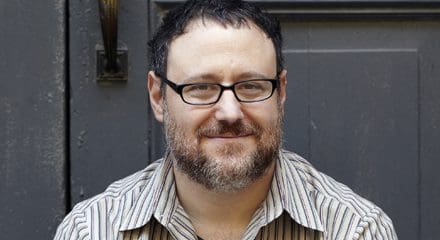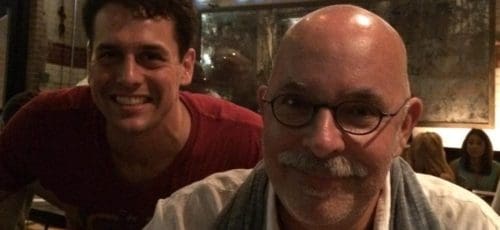Textbook Definition of Life: Interview with Dan Rothenberg of Pig Iron
“I think the question ‘Does a machine have a perspective?’ is another way of asking the question ‘What is alive and not alive?'”
 Brilliant in their innovation and shining in their craft, the Pig Iron Theater Company has earned its accolades for its artistic excellence. The recipient of several Obie awards, the company never fails to amaze in its fresh, interdisciplinary takes on current events and social themes of the human experience. Dan Rothenberg is one of the founders and artistic directors of Pig Iron, producing their newest work, A Period of Animate Existence. This production has amounted to a huge collaboration between actors, musicians, and a number of choirs, culminating in a show about the human experience of climate change, in the form of a symphony. We caught up with Dan to find out about how the idea for this show came about, and what it’s been like to put it all together.
Brilliant in their innovation and shining in their craft, the Pig Iron Theater Company has earned its accolades for its artistic excellence. The recipient of several Obie awards, the company never fails to amaze in its fresh, interdisciplinary takes on current events and social themes of the human experience. Dan Rothenberg is one of the founders and artistic directors of Pig Iron, producing their newest work, A Period of Animate Existence. This production has amounted to a huge collaboration between actors, musicians, and a number of choirs, culminating in a show about the human experience of climate change, in the form of a symphony. We caught up with Dan to find out about how the idea for this show came about, and what it’s been like to put it all together.
FringeArts: How did the title A Period of Animate Existence come into being?
Dan Rothenberg: Troy Herion proposed this title. He looked up the word “life” in the dictionary. It is a textbook definition. We were working with a few different sources of inspiration: Alan Watts, who talks about “the rocks peopling” as a way of imagining the beginnings of life on Earth, and understanding that we organic creatures are made out of exactly the same stuff as inorganic rocks. We looked at Richard Dawkins and “the Selfish Gene,” which talks about humans as big lumbering robots “operated” by genes within us. This grade-school question: “what’s the difference between alive and not-alive?” remains elusive for both scientists and philosophers, even today.
FringeArts: How did you go about gathering your key collaborators, what were the artistic conversations you were hoping to foster between not just them and Pig Iron, but between each other?
Dan Rothenberg: Some of the collaborators are folks I’ve worked with before for years, like Tyler Micoleau (lights) and Nick Kourtides (sound). These are people I trust who have contributed to some of the Pig Iron work I am most proud of. I am working with the librettists Kate Tarker and Will Eno, and with choreographer Beth Gill, for the first time. We were looking for artists who take on big ideas and who care about form. People who make work in which the form is front and center. Especially with choreographer Beth Gill, I wanted somebody with a deeply mathematical mind. Someone who sees the poetry in mathematics, since I feel that this piece is about seeing the world in terms of fundamental forces rather than as a set of relationships between people.
FringeArts: What prompted the five movements structure?
Dan Rothenberg: Gustav Mahler said that a symphony must be like the world, containing everything. So the five-movement structure is a symphonic structure. It’s our own “13 ways of looking at a blackbird.” A deliberate effort to get at something that’s too large to get your head around, by coming at it from five very different angles.
FringeArts: How do you determine the perspective of machines—and for that matter, the old and the young?
Dan Rothenberg: We started working with singers as young as seven and as old as eighty-one nearly a year ago. We asked them directly their perspectives on the future, on death, what they think about when they think about other generations. We’ve been surprised at how optimistic older people are about the future. I don’t know if that’s the wisdom of experience or a denial of some of what’s gone down on their and our watch. I think the question “Does a machine have a perspective?” is another way of asking the question “What is alive and not alive?” I don’t think it’s hard for us humans to anthropomorphize, to attribute human desires and feelings to plants, animals, cars. We’re always cautioned not to do this. It’s bad science. But it’s part of how we feel the world and how we imagine the world.
FringeArts: What are you discussing the most now with your collaborators and performers? And what do you see as the most important parts of the performance to fine tune?
Dan Rothenberg: We’ve tried hard to avoid an activist voice with this piece—we want to avoid haranguing or scolding as we investigate the landscape of emotions around climate change. As we contemplate extinctions, I keep talking about emotions that I don’t have a name for. I know what grief is, having experienced the deaths of people close to me. And I know what terror is. I think finding ourselves in the middle of extinction creates feelings like grief and terror, but it’s some other emotion that doesn’t have a name. On one hand I think we’re not the first group of people to believe that we are approaching the end of the world, and there are many people before us whose worlds were destroyed. But on the other, this piece is trying to get at a new category of experience and of emotion.
We’re often talking about when to be big and when to be small. One of my heroes, Toshiki Okada, writes very political plays but they take place in the minds of ordinary people, with very ordinary concerns. So sometimes we are following that lead, trying to get at the dull feelings of worry that pulse beneath the everyday. And other times we want to evoke the feelings of awe that arise when contemplating enormous scales of time and space. I guess we’re talking about how to represent the very big within the very small, and vice versa.
FringeArts: What makes tackling questions about life, or considering those questions, through performing arts, compelling for you?
Dan Rothenberg: Before I was married, in a moment of conflict, my wife-to-be turned to me and said “You have no sense of the divine in man.” And I shot back, “You know that’s not true! I just use different words for it!” I spent a long time identifying as secular and skeptical, but recently I have been feeling drawn toward the sacred. Even though I don’t know what the sacred is. I’ve been talking about this idea of “the sacred” with my collaborators—designer Mimi Lien trained as an architect and Troy is a composer, and I think it’s easier to think of the sacred in terms of music or architecture, to think about a volume of light or a pattern of music as “sacred.” To try to deploy people—us fleshy, imperfect, distracting humans—on a stage and still touch on “the sacred” has been the biggest challenge and most exciting aspect of this project for me.
Come see A Period of Animate Existence during the 2017 Fringe Festival, September 22 to September 24! Click here for tickets/more info.
Interview by Josh McIlvain. Additional text by Isabella Siegel.




